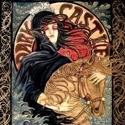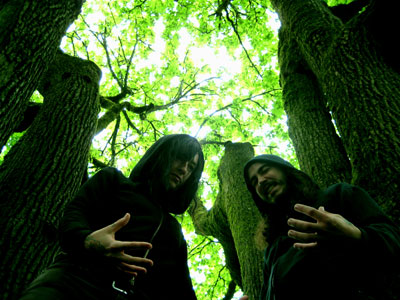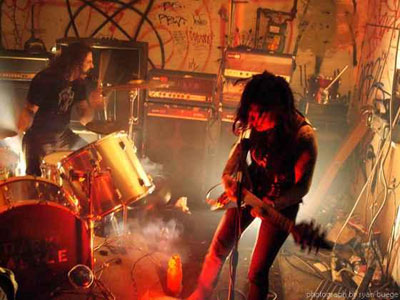
Dark Castle
The Shape of Doom to Come
Matthew Moyer
There is a rich tradition of heavy, evil, thrilling music rising out of the fetid swampland and the flimsy Bible Belt of sleepy Florida. The music made by Obituary, Deicide, Morbid Angel, Nocturnus, Massacre, Nasty Savage, Cynic, Malevolent Creation, Acheron, even the mighty Death was reason enough for pride, but now there are all sorts of new noises emerging. Most promising is the boy/girl doom duo from St. Augustine (you read that right), Dark Castle. Stevie Floyd (guitar, vocals) and Rob Shaffer (drums, vocals) are Dark Castle and the two of them, all by their lonesome, whip up as much of a racket as SunnO))) going full bore. With their new album Spirited Migration, they’ve radically expanded their sound, taking in psychedelia, krautrock, cult black metal, and Indian music alongside crushing grinds and ghostly drones. Spirited Migration was one of my favorite albums of 2009, and it was the one that began expanding Dark Castle’s audience from metal heads, suicide cases, and feedback junkies (guilty!), to those wanting new, adventurous loudness. As of this writing, Dark Castle has decided to hit the road for a never ending tour – sharing stages with Kylesa, Eyehategod, White Mice, and Liturgy – dedicating themselves totally to their art and music. Ink 19 caught up with musician/front woman/tattoo artist Stevie Floyd right before the band headed off to the whirlwind bacchanal that is SXSW (and then to Europe) for a portrait of a band on the cusp of…
It looks like you have some major touring plans for 2010. Are you looking forward to SXSW? Sharing stages with Shrinebuilder and Eyehategod has got to be exciting.
Looking very much forward to SXSW! We’re playing with some killer bands, can’t wait to play with Salome and Atlas Moth… we love those guys so much. Playing with Shrinebuilder and Eyehategod will be a pretty surreal experience, not to mention touring Europe in general.

In retrospect, are you happy with the way that Spirited Migration turned out and the way it was received by audiences?
Overall yes, especially given the amount of time that we had to record. People have been so receptive to it, considering all of the different elements we were trying to incorporate. We definitely worked really hard on it, and Phillip Cope did an incredible job producing it. He really captured our live sound on the album which is something that is critically important to us.
Have you found your audience expanding as of late? Your work is really being talked up in a number of blogs and magazines that don’t write about metal as much.
I know. It blows me away how open-minded people are towards our music, because it’s pretty heavy stuff, but for some reason we do get a lot of people who aren’t normally into metal digging it. The audiences have been very diverse, and we love that of course. We did eight tours last year and it definitely seems that the crowd expands with each one. The vibe is different every night and that’s what makes touring so fun and interesting.
Tell me about the writing and recording of Spirited Migration. How long had you been working out the songs? Did you write anything in the studio? Did you do much in the way of overdubbing or multitracking?
A couple of the songs were on our EP, so those were written a little while before the others. We also had a demo before that with a different song on it. We try to keep our recordings as live as possible. That’s one thing that Phillip is so good at. I actually wound up re-recording the guitars on the album a couple of times, just so that I would have the most live vibe going on as possible and very minimal amounts of punch-ins. We set up four different guitar rigs and one bass rig that I played through all at once. Then I recorded all the tracks over top of the initial ones. So I guess there were 10 rigs altogether. It was so important to me that it sounded similar to our live show. Rob of course nailed the drums in no time with hardly any problems. We were really happy with the way the drums came out as well. His set-up live is pretty different, with marching drums and all.
A couple of the tracks were meant specifically for the album and not for playing live. The song “Spirited Migration” is an acoustic track that Rob loosely wrote ahead of time that we thought would transition well into “Growing Slow,” being that it was also written in a Hungarian scale. Phillip made him record the song outside, which I thought was a nice touch. You can hear a little bit of the cars driving by in the background. “Weather the Storm” is also something Rob came up with using lots of synths and spacey atmosphere and was pretty much inspired by Tangerine Dream. I had been listening to lots of Sonic Youth the day I wrote “Grasping the Awe,” so some of the spoken word stuff would be hard to do live as well. We also pre-recorded some of the samples and loops from our vintage organ. We use those live too.
What were some of the musical influences on the album?
Well, we use a lot of multicultural scales in our writing, mostly Japanese and Hungarian. We collect a lot of old records like Harps From Around the World and Japanese Flutes, or Ravi Shankar sitar records. Lots of world music as well. Of course we grew up on metal, Death is our all time favorite metal band, and pretty much why Dark Castle is a band today. Yob and Bathory are huge influences, along with Meshuggah, Morbid Angel, Nile, Soilent Green. We love black metal, listen to a lot of Leviathan, Lurker of Chalice, Twilight. Lots of ’70s progressive rock like old Scorpions, Camel, Deep Purple, Rainbow. Grunge as well. We love and grew up on Soundgarden and Alice in Chains!
What is your song writing process? Some of the music on the album was psychedelia-tinged, but the song structures were way more focused, with very little in the way of jamming. Do the songs expand organically from an initial idea or riff?
We both write equally. Rob is an amazing guitarist, so we both come up with ideas, whether it’s on guitar or drums, and just add to it. We’re pretty specific about songs staying in a scale. I know “jamming” works for some people, especially if they’re writing in a pentatonic blues scale, but not for us really. The scales we use are pretty weird already so every note has to be in the scale or else it won’t work and can easily sound off or out of key. I feel like the more attention and time you give a song, the better it’s going to be. Some of our songs were re-written multiple times until it felt right. We also are really into different time signatures and plan to get more into that on the next album. So our writing experience is more like a math class and less like a party!
How was the making of Spirited Migration different from Flight of Pegasus?
Flight of Pegasus, we feel was a good first EP but was a little all over the place as far as our sound and style. We wanted all of these different elements going on, which I think is good, but keeping that consistency was the hard part. It was completely, 100% live and raw. I was still figuring out how to do my vocals and you can definitely hear my voice fading away as the album goes on! We also recorded that in two days so you know how that goes. Spirited Migration was a lot more planned and thought out. We also only had a few days to record that album but Phillip Cope was a big help for sure. He did an amazing job producing it. Although we didn’t record on tape it was great working with Jay and Steve at the “Jam Room” who have lots of experience in that area to sort of capture the warm, live energy tape has, but using more modern equipment.

You spend a lot of time with the design and graphics on your album sleeves – does your tattooing work feed into your other album artwork and vice versa? What inspired the cover art for Spirited Migration?
I definitely did spend a lot of time on the cover. It’s a 5’x5’ painting on wood using different stains and washes. Tattooing has changed everything about the way I paint. It has helped me become more precise and patient with painting. The cover was sort of a representation of a new beginning as a band and just life in general. I feel like it’s important to see every day as a new beginning and to approach it as if it was your last day on Earth, to put all of our energy and awareness into everything we do.
You’re still based in St. Augustine, FL. Any plans to leave or do you find living in North Florida influences your music positively? Do you get much support locally?
We love St. Augustine, it’s the oldest city in the country so there are endless amounts of inspiration for music and art. It’s also nice to come home from tour to a chill environment rather than a big busy city. It works well for me with tattooing too. I can come home and really concentrate my focus on art without a lot of distractions. It does get a little boring at times but that’s why we tour so much. It breaks it up nicely. Not sure how long we will live here. Probably not forever, there are so many beautiful places. Eventually getting off of the grid is what I would like. We get a lot of support from Florida. There is such a bond and community here with bands, regardless of the genre of music. Everyone helps each other out and sticks together.
What sort of groups do you feel a commonality with right now? Any other Florida bands?
There are so many bands that we’ve played with and that have helped us… Zoroaster, Baroness, Black Cobra, Minsk, Rwake, US Christmas, Deadbird, Black Tusk, Sourvein, Torche. So many Florida bands that we love…Civilization, Cult of Ouroboros, Antarctic, Hollow Leg, Junior Bruce, Six Dead Horses, Khann, Flying Snakes, Dark Faith, By the Horns.
Does being in a duo give you more creative and sonic flexibility? Listening to the album, I don’t find myself missing a bass or a lead guitar at all. Does it make touring easier?
Being a two-piece has its ups and downs. Decisions are of course easier, less mouths to feed. Loading and unloading the van sucks, not having anyone to watch merch, less people to throw in on gas… sucks! Overall I think it’s worth it though. It is simpler. We try to have more than enough equipment to overcompensate for the lack of bass and second guitar. That is our biggest goal.
What is your first memory of music?
My dad was obsessed with Pink Floyd and had all of his records on record racks around our living room… Oh, and playing classical piano since I was five.
What got you into metal and heavier music? What was it that made you want to play music?
Being a depressed, angry, rebellious teenager! Something about the heaviness and aggression behind metal intrigued us from day one. We knew that was what we wanted to do. Dropped the piano when I was 12 and picked up a guitar.
How did you both meet and what made you decide to start playing music together?
Rob was on tour in a death metal band called Into the Moat in 2005. I met him at a show. I was also in a death metal band called Cystic Dysentery. We left those bands to focus on forming Dark Castle. We connected immediately being that Death was our favorite band and all. We had the same ideas for writing music and a certain connection that is hard to explain. It was originally going to be way more technical with drum machines and two guitar parts occasionally. It gradually slowed down and got simpler.
What sort of lineup or instrumental changes did you go through before settling on this formation?
Well, like I said before, we had a drum machine and played one show that way. It wasn’t really working out and was lacking live drums. So Rob took on learning drums sometime around 2006. He quickly became an amazing drummer. We had smaller drums at first and two half stacks. I gradually started collecting Sunn and Ampeg tube heads, several Sunn cabs and Rob got marching drums that he converted into what is now his drum set. We knew that we needed large drums to be able to cut through the intensity of four cabinets.
What is it about more doom and drone-based music that made you want to go beyond listening and actually create your own take on it?
We’re really not sure. For years it was always “the faster the better.” We just felt that keeping it simpler and slowing it down some would allow more intensity and emotion to come through for Dark Castle.
Do you have any long term goals as Dark Castle or musicians in general?
We stay really productive. We live and breathe music. There is hardly a day that passes when we aren’t writing, recording, or working on merch for the band. I also tattoo a lot so there isn’t much time for anything else. Not watching TV is a huge help. Haven’t had a TV channel in about eight years. We plan on releasing as much music as possible. We have two vinyl releases coming out this year along with another full-length ready to go. Lots of touring coming up as well.
You tour pretty relentlessly, do you feel that your music communicates better live or on record?
We definitely communicate more with our live show. That’s why touring is more important these days than ever. That’s what really moves people and gets inside of people. I know it is for us at least. It’s about creating a whole alternate atmosphere. We put our full intent and energy into our live show. Having a solid album is important too, but when we think about our favorite bands… it’s always the ones that really bring it live that stick out.
What sort of projects will you be working on next?
We have two vinyl releases coming out this year. We’re in an amazing documentary about metal from the South called Slow Southern Steel. We have another full-length written. We’re heading to Europe in April with Kylesa, which we are very excited about.
Dark Castle: http://www.myspace.com/darkcastlemetal ◼












